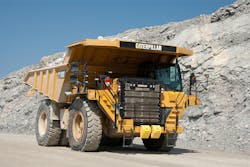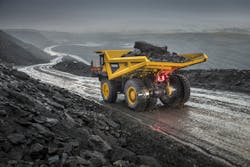Suited for applications with well-maintained haul roads when big loads of rocky, abrasive material need to be hauled, the rigid dump truck is a rugged workhorse that can move more material faster, more efficiently, and at a lower cost than an articulated dump truck.
In the competitive truck market, three manufacturers make a case for their heavy-hitting haulers.
Komatsu
Komatsu offers a full lineup of mechanical-drive rigid haul trucks from the 40.3-ton 514 hp HD325-8 up to 101.6-ton 1,140 hp HD785-8. “The recent introduction of the HD785-8 completes the updated eighth-generation lineup, offering time-tested features and including a few new unique ones,” says Sebastion Witkowski, product marketing manager. “These rigid haul trucks are loaded with technology to help improve operator efficiency and productivity.”
That technology includes:
- Komatsu Traction Control System provides optimum traction in soft or wet road conditions. It monitors for wheel slippage at the rear axle, with an acceleration sensor that determines high-speed turns versus slippage. If slippage is detected, the brakes are applied independently to each wheelset automatically without operator input and without compromising steering.
- Komatsu Advanced Transmission with Optimum Modulation Control System with Skip Shift function features fully automatic control to select the optimum gear according to vehicle and engine speed for better fuel mileage. Skip shift function automatically selects a gear position, depending on the grade, eliminating the need to downshift when traveling uphill.
- Automatic Protective functions continuously monitor machine operating conditions through the machine's electronic control system and automatically apply protective functions as needed to protect the machine from conditions that could result in over-run or overloading of the drivetrain components.
- Automatic Retard Speed Control allows an operator to set the desired downhill speed. The haul truck will automatically apply the multiple-disc oil-cooled brakes to maintain it.
- Auto Idle Stop automatically shuts down the engine if the truck is left idling for a predetermined set time of 5–60 minutes.
- Integrated Payload Meter is a tool to manage the hauling cycle payloads and to analyze production volume and working conditions of the haul truck.
- Komtrax Plus is Komatsu’s telematics systems for large machines, providing data on fuel consumption, location, abnormality alerts, operator ID, and payload meter.
- Energy Savings Operation ECO Guidance is an in-cab monitor that displays messages with suggestions on how the operator can run the machine more efficiently, such as guidance to avoid excessive idling, reaching hydraulic relief pressure, brake dragging events, throttle use when lowering the dump body, and reaching steering relief pressure. It also displays real-time fuel consumption.
In addition to the features on Komatsu’s existing lineup, the recently introduced HD785-8, a new rigid frame haul truck, features a 1,140 net hp Tier 4 final engine and a rated payload of 101.6 tons for hauling in heavy construction and aggregate applications.
“Komatsu’s design target was to maintain best-in-class speed on grade and downhill brake retarding performance while adding new technology and creating a more comfortable operator environment,” says Robert Hussey, product marketing manager. The HD785-8 incorporates many features introduced in the HD325-8 through HD605-8 models, while introducing a few unique to the HD785-8, such as:
- Variable horsepower control, which senses whether the truck is loaded or unloaded and matches the engine output to the application. If the truck is unloaded, it will lower the engine output to save fuel with no loss in production. If the truck is loaded, the operator will have full horsepower for the highest production levels.
- KomVision, a six-camera system that provides the operator with a 360-degree view of the working area around the truck. Radar obstacle detection, to be released later this year, will provide the operator with an audible and visual alert when an object is detected in the working area. The HD785-8 also has a dedicated rearview monitoring system that utilizes a separate monitor and camera from the KomVision system for increased operator awareness.
A brand-new cab provides many features for operator comfort, including air suspension, heated mirrors and operator seat, and a 7-inch color LCD monitor.
The new truck is equipped with the Komatsu Traction Control System, which functions automatically and enables the HD785-8 to maneuver in poor underfoot conditions while maintaining strong steering performance.
A new machine immobilization locks out the steering, hoist, and transmission—useful if the machine is being jump-started to prevent the operator from taking off before the technician has disconnected the jumper cables.
A variable displacement piston pump for steering and hoist hydraulic circuits replaces a gear pump, resulting in cooler hydraulic oil temperatures and reduced fuel consumption, Hussey notes. A new reversible hydraulic fan and modular radiator core provide more efficient cooling. Since the HD785-8 does not have a Selective Catalytic Reduction system, Diesel Exhaust Fluid is not required.
Caterpillar
Cat’s G Series off-highway trucks are fuel-efficient and productive. Mike Mesnard, product application specialist, says, “We continue to utilize new technologies and strategies to squeeze as much performance and efficiency out of our OHT platforms while still delivering the durability and reliability expected from Caterpillar. Our goal, as always, is to give customers a solution that lowers their cost per ton and hauls profits to their bottom line.”
Their G Series consists of the 770G and the 772G, both Tier-IV-compliant, with improved operator control, and other features for operator comfort and safety and ease of maintenance, such as:
- stairs and grab rails
- LED access lights on stairways
- a door that opens to the front for easy access
- windshield handrails
- two ground-level service access points
- storage for optional wheel chocks on the front bumper
Both models also feature an aluminum radiator with thicker tubes for stronger joints and better leak protection; higher headlights for better sightlines; a steering and fan hydraulic tank that is separate from the main system for better cooling and easier servicing; easy-to-see oil level sight gauges; rear struts positioned down to extend seal life; a WAVS camera that provides a 115-degree field of vision to the rear of the machine, with a 7-inch color monitor in the cab; and a brake wear indicator.
While Cat doesn’t currently offer any new model rigid trucks, Mesnard says the 777, 775, and 773 off-highway trucks have a redesigned cab with:
- improved ergonomics
- better visibility across the front of the machine, with more glass in the front viewing area and an optional object detection system
- a seat positioned further left in the cab for improved operator visibility while backing up
- a full-size trainer seat for longer training shifts
- an adjustable console that houses single shift/dump lever functionality
- color touch screen display for improved camera images, machine information retrieval, and access to machine functionality settings
- a new Cat Comfort Seat with integrated heating and ventilation and improved adjustability
- a new console with an integrated hoist-and-shift lever
- additional storage
- throttle lock for long uphill grades
- reduced interior sound
The 777G, which replaces the 777F, focuses on fuel efficiency, enhanced visibility, operator comfort, convenience, and safety. Safety features include an emergency egress through a right-side hinged window and a ground-level engine shutdown switch, as well as a secondary steering system in the event of the primary steering system failure.
Slope-holding capability is provided by wet-disc brakes at all four corners and a parking brake. Automatic retarding adds to positive control on downhill grades, and a new steering-sensitive traction-control system assists when ground conditions deteriorate.
Auto Neutral Idle allows the 777G’s transmission to intermittently shift to neutral when the truck is idling in a forward gear to avoid stalling the torque converter and increasing engine speed. Engine Idle Shutdown stops the engine when the truck idles in park for more than a preset interval.
The 777G has two operating modes: Standard Economy and Adaptive Economy. Standard Economy saves fuel by reducing engine power by 0.5 to 15%, based on the conditions at a particular site. Adaptive Economy requires a production baseline for the site and, as the truck travels, the system automatically evaluates the power rating needed.
The efficiency of the 777G's performance is further enhanced by 7% more engine torque and an increase in top speed. The engine delivers 1,025 gross horsepower.
The 777G’s structure is designed for durability in harsh earthmoving applications. Box-section castings are used in high-stress areas, while a new front frame design increases the approach angle on ramps and grades. The Dual Slope Body, designed for optimum material retention on haul roads with steep slopes, provides stability by carrying material low and centered. Two side-board sizes increase the capacity for lighter weight materials.
Volvo
Despite having produced rigid haulers under the Terex brand for decades, Volvo wanted to introduce a Volvo-branded model, so it plans to introduce its 100-ton R100E Tier 4 Final rigid hauler in the fourth quarter 2020 (or possibly delayed to next year due to COVID-19 issues).
The largest hauler in its lineup, the R100E will be powered by a 783-kW Cummins engine and feature a flexible frame for less stress and increased longevity, says Robert Palermo, product manager for off-road trucks for North America. The R100E’s durable design begins with a body manufactured from high-impact and abrasion-resistant 400-HBW-hard steel.
Especially suitable for applications where the site’s slope is less than 10% and the haul road is hard-packed, the R100E features a combined drivetrain for high torque capability and pulling performance, with a manually-activated ECO mode for long-distance hauls and high-speed applications. Volvo's Dynamic Shift Control automatically adjusts the transmission shift points according to the worksite and operational inputs.
It has a new bed with a double-tapered V design, Palermo says. The V-shaped body enhances load retention for fast cycle times. “The bed is pitched toward the center of the truck,” which has a lower center of gravity for more stability on turns due to less load shifting, he explains. To further accelerate cycle times, he says, Volvo will be coming out with “bigger loading tools” soon.
The cab is designed for operator comfort, Palermo continues. Not only does the operator have an air-suspension seat, but the entire cab benefits from reduced vibrations and exterior noise because it’s fitted onto viscous-type isolation mounts that improve ride quality. The wide-spaced front suspension absorbs surface shocks for a smoother ride and the new low-effort steering system makes it easier on the operator.
Volvo Smart View provides a 360-degree bird’s-eye view, Palermo continues. Using ultra-wide-angle exterior-mounted cameras, the system provides visibility of the vehicle and surrounding work area on an in-cab display.
Palermo lists features that help operator control, such as a retarder on the braking system, a proprietary co-pilot system, and real-time mapping of the trucks onsite. Haul Assist will allow operators to monitor traffic on the job site in addition to keeping an eye on the performance of their fleet to optimize haul cycles. Originally introduced in 2019 on Volvo’s articulated hauler fleet, it helps increase productivity and safety.
Haul Assist Map uses GPS to locate the position of all haulers outfitted with the technology. Being able to anticipate arrival time at loading and dumping areas can reduce congestion and wait times. Where visibility is restricted, it helps operators see the location of other trucks by communicating with other machines via Volvo Co-Pilot’s digital connection, which can also record a truck’s speed, send an alert when approaching a single-lane section that’s already occupied, and plot efficient routes.
Another Haul Assist feature is on-board weighing, which helps eliminate under- and over-loading for increased productivity. Exterior-mounted pressure sensors monitor loads and transmit data to the on-board display. The Map feature adds the ability to measure the amount of material moved between various points on a job site.
Configured with CareTrack telematics, the R100E provides data such as fuel consumption, machine utilization, and excessive idling reports, Palermo notes.
A transmission retarder and neutral coast inhibitor aid machine control on downhills, while the engine overspeed protection automatically slows the machine down to safe limits. Palermo indicates that it comes equipped with wet-disc brakes on the rear and dry-disc brakes on the front.
Volvo’s first foray into the rigid dump truck realm stems from customer demand and is the result of research and development based on their ADT models and OTR trucks, Palermo says. “We brought the rigid up to speed.”
No matter which OEM manufactures it, when an application requires a large amount of material to be moved, a rigid hauler is better suited because its size, capacity, and speed mean it will be more cost-efficient.













